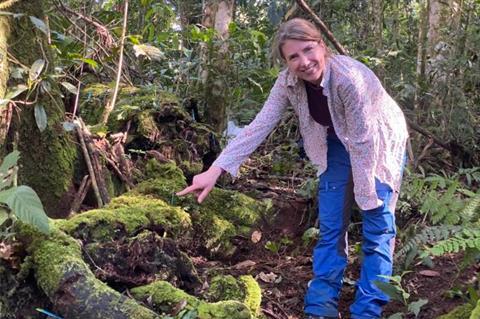One of the first research centres in the world to specialise in how much gas is released by plants, soil, fungi and bacteria has opened at the University of Copenhagen.

Volatile gases are emitted into the atmosphere by nearly everything around us – both by human creations and from nature itself: furniture, cosmetics, plants, fungi, bacteria – and even our own bodies. These chemical compounds, which evaporate easily and mix with other things in the air, are collectively referred to as volatile organic compounds (VOCs).
In nature, all organisms produce VOCs and use them to communicate with each other and protect themselves from enemies by way of scent and chemistry. For example, leaf-eating insects cause plants to begin releasing VOCs that eventually repel the same insects. On the other hand, flowers make themselves irresistibly delicious to attract honeybees and ensure for their own pollination. In this way, organisms ‘talk’ to each other across ecosystems with the help of VOC gases.
Climate influence
But VOC gases from ecosystems also influence global climate. Among other things, they contribute to the formation of more atmospheric greenhouse gases. The problem is that we do not yet know by how much. Researchers at the University of Copenhagen have now dedicated the next few years to finding out.
“They’re a bit of a joker in the climate equation, because we still know very little about the quantities of gases emitted. This is knowledge we’d like to have. When we get the numbers right, they can be included in the broader climate equation and provide us with more accurate climate models,” says Professor Riikka Rinnan, head of the new research center, VOLT – Center for Volatile Interactions, at the University of Copenhagen’s Department of Biology.
Together with three other Department of Biology researchers, Professor Rinnan has received a grant of DKK 60 million (EUR 8 million) from the Danish National Research Foundation to run the centre for the next six years. The official opening ceremony for the center took place on 19 June 2023.
Complex impact
VOCs are found as thousands of chemical compounds. For example, in compounds like isoprene and methanol. While we know a lot about how greenhouse gases like CO2 and methane impact climate, the effect of VOCs is both more unexplored and complicated.
They are known to extend the lifetime of methane in the atmosphere, but at the same time, VOCs can form tiny airborne aerosol particles that reflect solar radiation away and thereby cool the climate. So, their overall climate effect remains uncertain.
“While the effect of greenhouse gases in the atmosphere is quite simple, understanding the effect of VOCs is more difficult because their effects on the climate vary and go both ways. Furthermore, VOCs react differently in the atmosphere depending on what else is in the air. Therefore, the effects are quite local and vary from place to place, which adds to the complexity,” Riikka Rinnan explains.
Deep insight
The idea behind the VOLT center is to gain deep insight into how the complex interactions across organisms, environment and the atmosphere function. This involves understanding all of the biological processes involving VOCs in nature – right down to how each type of moss, fungus or plankton emits and consumes gases.
“Previously, we discovered that microorganisms both produce VOC gases and ‘devour’ them as an energy source. For example, while a plant may produce 100 units of VOCs, microorganisms on its leaves may consume 20 units, so that only 80 are emitted. Indeed, opposing processes are always underway, and we have a poor understanding of them today,” says Riikka Rinnan.
“So, it is important to find out both how much gas the organisms produce, as well as how much they absorb in order to gain a more accurate picture of the amount and composition that escapes from ecosystems and into the atmosphere.”
Focus on plankton
The researchers’ ambition is to gain a general understanding of the interactions between all types of organisms and VOC gases. And since previous research has focused on plant gases, researchers at the new center will turn more of their attention towards other organisms.
“Now we need to look at all of the organisms that were left out of previous research. This includes soil – with its community of bacteria and fungi – plants such as mosses, and aquatic organisms like plankton. But we need to make some very difficult measurements, as the VOCs are reactive, and their concentrations are generally very low.”
The center’s first research projects will be on VOC gases in plankton, soil and moss.
In addition to Center Director Riikka Rinnan, who is a professor of ecosystem-atmosphere interactions, the centre is led by principal investigators Lasse Riemann, Anders Priemé and Kathrin Rousk, who are respectively experts in marine microbiology, soil microbiology, as well as symbioses and organism interactions.
Three impacts of VOCs
VOCs have three main effects on climate.
- VOCs form ozone, a greenhouse gas that also happens to be toxic to plants. Ozone reduces photosynthesis and a plant’s ability to absorb CO2 from the atmosphere.
- VOCs disappear from the air in the same way as the powerful greenhouse gas methane: Both of them are oxidized in the atmosphere. Because VOCs are more reactive than methane, elevated VOC concentrations extend the lifetime of atmospheric methane.
- VOCs contribute to the formation of aerosol particles that reduce global warming by reflecting the sun’s radiation, which can thereby cool climate. When aerosol particles grow large enough, they can also contribute to cloud formation.







No comments yet